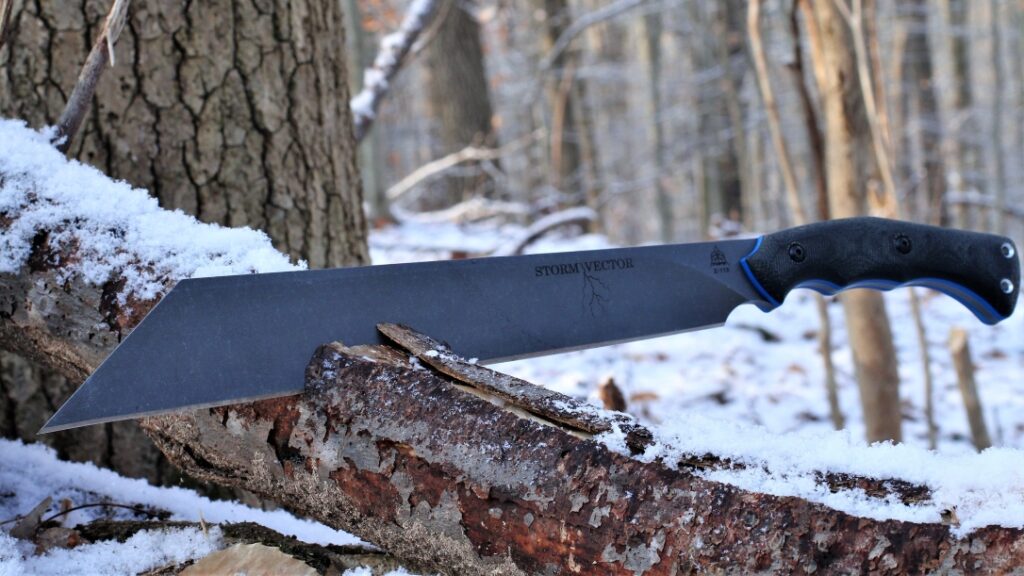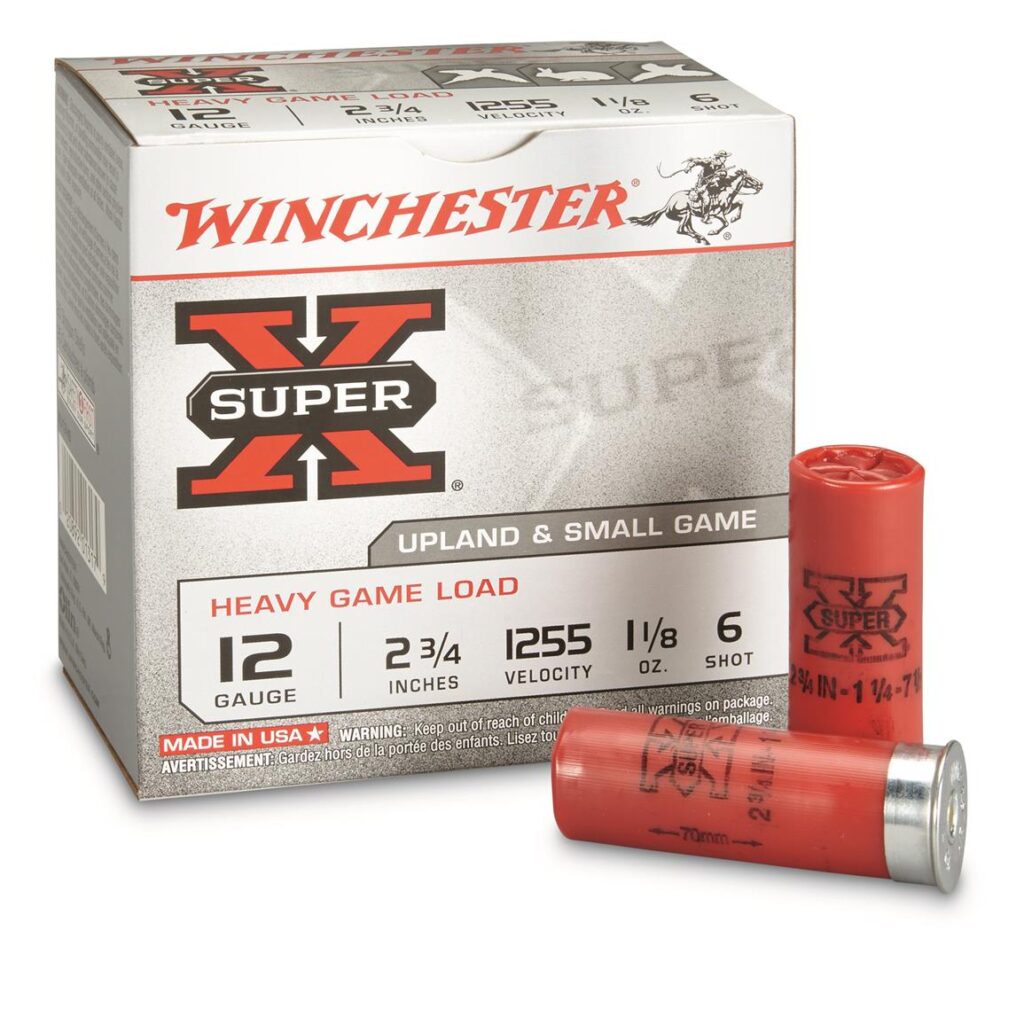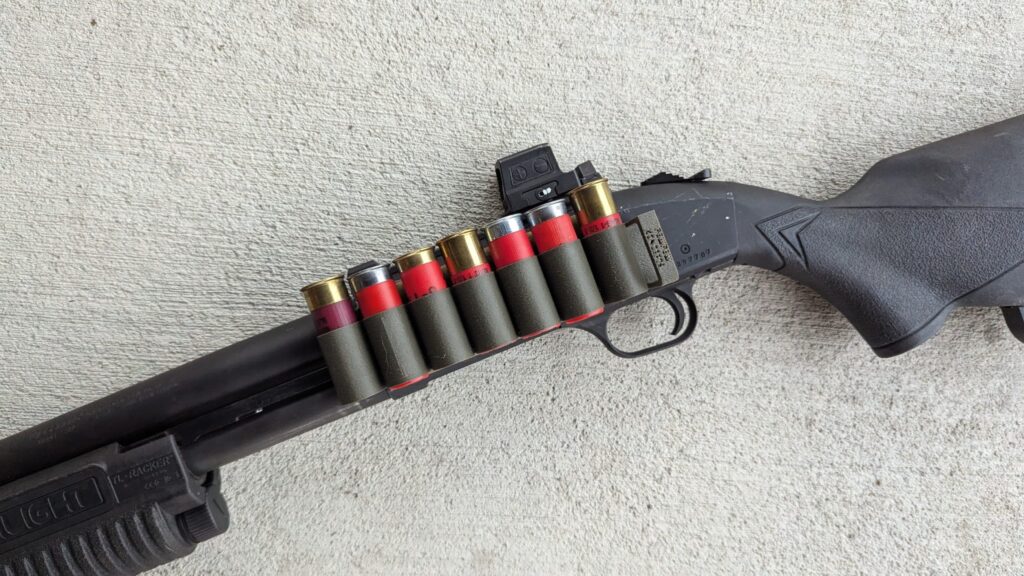A few months ago, I came into 20 rounds of 8-pellet Hornady 12-gauge TAP Versatite (Item #86265). It is probably best described as Hornady’s counterpart to Federal Premium’s Tactical Flite Control LE 133 00 8-pellet buckshot load. After all, the 12-gauge TAP Versatite and the Federal Premium LE 133 00 are both marketed towards law enforcement. Likewise, both are loaded in 2 ¾ inch shells, and both also have reduced recoil loads: at 1100 fps and 1145 fps, respectively.
Keep in mind that this also isn’t a Flite Control vs Versatite article, as 20 shells through a single shotgun wouldn’t prove anything other than what my shotgun prefers. Variances between lots of the same shotshells SKUs do exist, and it’s also something I’ve seen firsthand–even when shooting with the same shotgun.
Furthermore, the internal compositions of individual shotgun barrels, even from the same production run, have enough nuances to affect how they throw patterns without regard to shells being from the same box or batch. In short, this post is for entertainment purposes only, but also for the love of shotguns.
Advertisement — Continue Reading Below
Patterning Versatite With The Beretta 1301 Tactical
I patterned all 20 rounds of Hornady TAP Versatite by shooting them at blank pieces of cardboard at 5, 10, 15, 20, and 25 yards over two range trips, as time allowed. Hornady packages its shells in packages of ten and ships 100-round cases. Both boxes that I shot came from the same case.
To pattern them, I took what I learned from Erick Gelhaus about patterning shotguns during the inaugural Thunderstick Summit. So, I fired two shells at each distance at the same spot. I just cheated and used the red-dot sight since my Beretta has an Aimpoint H2 that sits on an original Aridus CROM mount.
Keep in mind that the point of impact doesn’t match the point of aim since the sight is zeroed for a different load—the Federal Premium Tactical Flite Control LE 127 00 (9-pellet high velocity).
Advertisement — Continue Reading Below
Pattern Descriptions
To pattern the Hornady TAP 12-ga loads, I used clean sheets of cardboard and labeled them accordingly. I divided this fun experiment over two range trips as time allowed, and the results are divided between “Target 1” and “Target 2.” Each of these “relays” consisted of 10 rounds total, with two shots being fired at each distance, as I referenced in the previous paragraph. The grand total adds up to two boxes (20 shells).
5 Yards:
At five yards, the payloads from all four rounds remained inside the wad, effectively stacking 0.73-caliber holes right on top of each other on both Targets 1 and 2.
10 Yards:
At ten yards, I counted fifteen distinct pellet holes on Target 1. This pattern measures approximately four inches through its “core.” There is a lone pellet roughly 3.75 inches beneath the main cluster of pellets. One of the wads punched the cardboard clean through while the other one impacted sideways. Both can be clearly seen. There’s also a chance that the 16th pellet could have passed through the same hole another pellet previously did.
Advertisement — Continue Reading Below
On Target 2, the impacts closely resemble the 5-yard patterns. But there are a few individual pellets immediately below the 2-inch hole and a flier above. Extreme spread for Target 2 at ten yards is 3-inches.

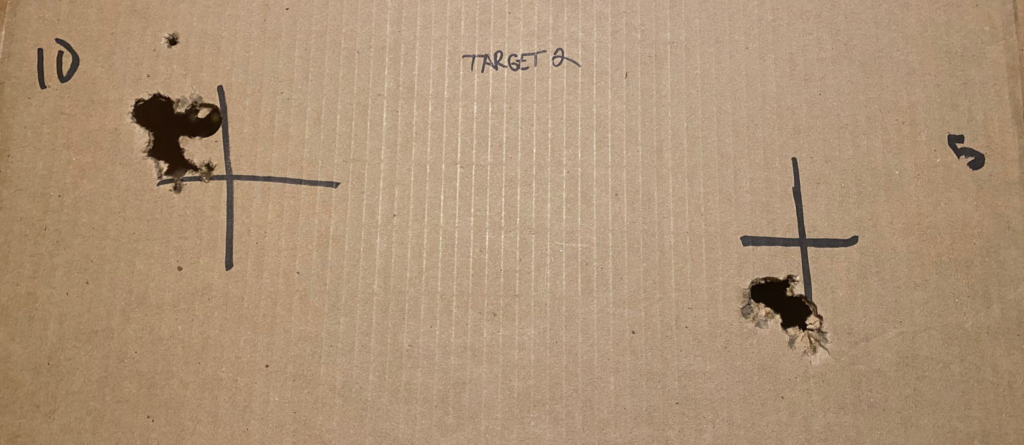
Advertisement — Continue Reading Below
15 Yards:
At fifteen yards, patterns started to open up on both targets. On Target 1, I counted fifteen pellet holes across a 10.75-inch extreme diagonal spread. But the core of both payloads sits in an 8-inch diagonal cluster. Both wads impacted the cardboard sideways, too.
The pattern on Target 2 shows 16 distinct pellet holes with a more rounded cluster measuring approximately 5 inches. I am unsure whether the two most extreme flyers are part of the Target 2 20-yard pattern, and in haste, I neglected to mark these in between shots.
20 Yards:
When patterning buckshot with sophisticated wads, be they Flite Control or Versatite, I’ve noticed that one can usually start finding wads in front of the firing line at this distance. This suggests that shot columns are mostly separated from wads, but it’s not always the case either. In fact, both shots I fired at Target 1 are the biggest anomalies I’ve seen whenever patterning any shotgun.
Advertisement — Continue Reading Below
The first shot printed an amazing and extremely tight pattern that measures 1.75 inches at its widest points. However, I could only count seven distinct pellet holes. I’m unsure what happened to the 8th pellet, and I’m assuming the wad never struck the cardboard. Beyond that, the second shot is the strangest one I’ve ever seen.
Approximately 7 inches up and to the left from this “surreal” 1.75-inch 20-yard pattern, there is a very clean circular hole that looks exactly like one of my 5-yard shots. I distinctly remember that the first shot at Target 1 was the magical pattern. My suspicion is that the wad and shot column from the second shot never separated, so both acted like an extremely slow-flying makeshift slug that began drifting off-course.
20 Yard Pattern
Target 2’s 20-yard pattern shows 12-13 holes. One of the wads from the 15-yard shells impacted sideways in the vicinity of where I was aiming. So, there’s a chance some or all of the missing pellets could have also traveled through that hole. Or, as I mentioned above, the extreme fliers that I thought were part of the 15-yard patterns could actually belong here.
Advertisement — Continue Reading Below
Fliers aside, the core pattern measures approximately 7 inches end to end, and the suspicious flier would add another 2.5 inches for a total of 9.5 inches. The 20-yard pattern on Target 2 looks more in line with both Target 1 and 2’s 15-yard patterns. Even on the best of days, that first 1.75-inch pattern from Target 1 is like a unicorn.
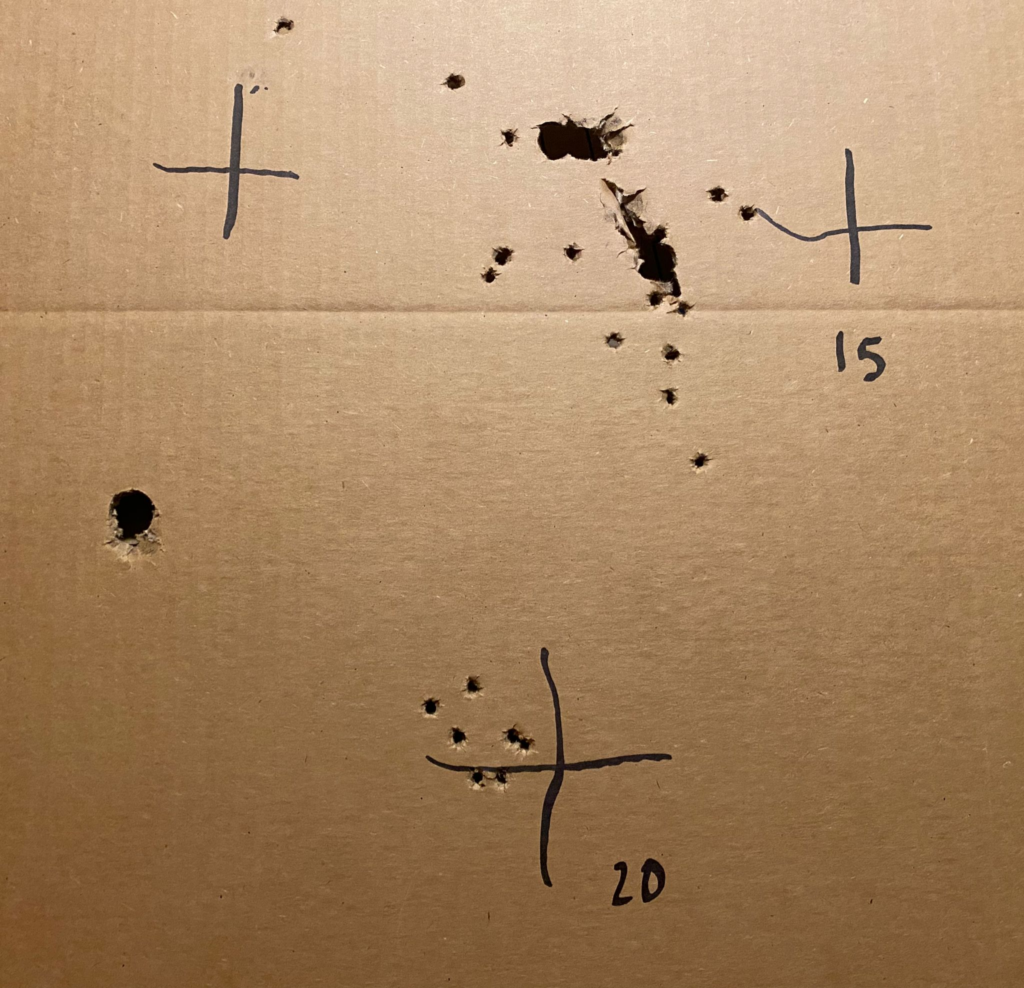
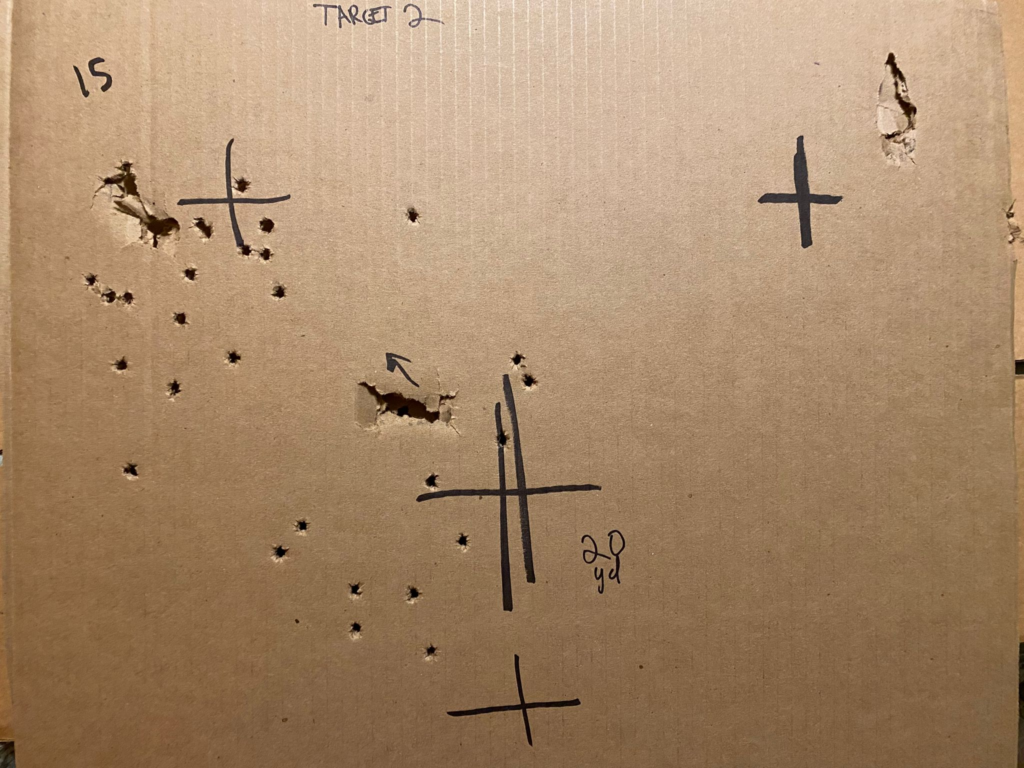
Advertisement — Continue Reading Below
25 Yards:
I counted all sixteen pellet holes on both Targets 1 and 2. The extreme spread on the first target measures 18 inches diagonally from bottom left to top right. The inner cluster for this target measures about 8 inches.
Target 2’s pattern was a little tighter, with an extreme spread of 12.5 inches and an even tighter inner cluster that measures about 5 inches. As expected, neither wad struck the first target, but both wads impacted the second target diagonally.

Advertisement — Continue Reading Below
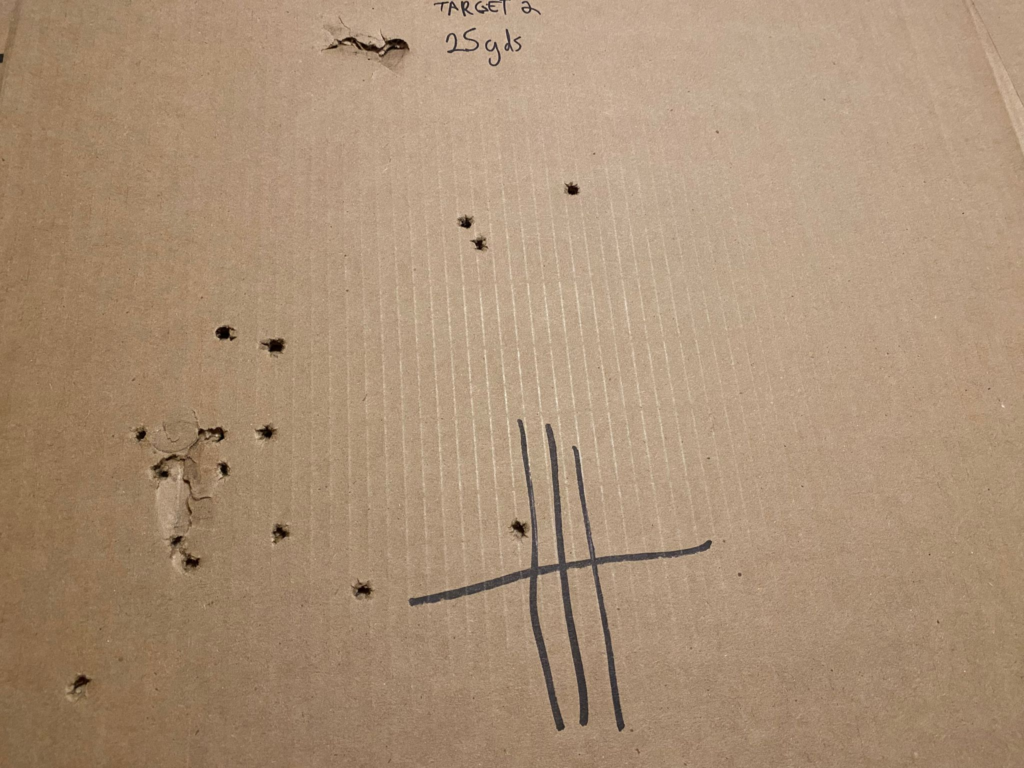
To be continued in Part 2…

